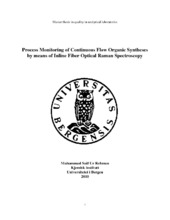Process Monitoring of Continuous Flow Organic Syntheses by means of Inline Fiber Optical Raman Spectroscopy
Master thesis
Permanent lenke
https://hdl.handle.net/1956/4033Utgivelsesdato
2010-02-08Metadata
Vis full innførselSamlinger
- Department of Chemistry [432]
Sammendrag
The objective of the current study was to investigate the feasibility of the inline optical fiber Raman spectroscopy as a tool for the process monitoring of the continuous flow organic syntheses. The synthesis of 2-bromo-3,4,5- trimethoxytoluene (product) was studied as a model reaction under a set of different conditions. The reaction was carried out under the batch as well as in the multi jet oscillating disc (MJOD) milli reactor. The reaction was varied by doubling the concentration of the substrate; 3,4,5- trimethoxytoluene (0.15M, 0.3M and 0.6M) whereas the concentration of the solvent (acetic anhydride) was kept constant. The Raman instrument was adjusted to record five spectra per minute. The recorded spectral data was then preprocessed employing the second order differentiation to minimize the band overlapping in the spectra. Multivariate data analysis namely, Principal Component Analysis (PCA), was used to evaluate the spectra due to the presence of overlapping bands for the purpose of process monitoring. The measurement system was tested against the possible process disturbances, the oscillator and the feeding pumps. PCA showed that these disturbances had no impact on the measurement system. The Raman instrument successfully monitored the different organic reactions and discriminated them on the basis of the type of variation occurred. The Raman frequencies; 675, 1050 and 550 cm-1 were assigned to the solvent, substrate and the product. The various reactions undergoing any disagreement were differentiated from the normal reactions mainly due to the temperature effect, malfunctioning of the pump, lower conversion of the substrate, lower yield of the product, formation of the intermediates etc. The offline results obtained from the NMR spectroscopy verified the outcomes of Raman measurements. Thus, it was concluded that the optical fiber Raman spectroscopy proved to be a reliable, rapid and sensitive inline analytical method for the monitoring of the organic processes. Raman spectroscopy along with an appropriate chemometric tool could be employed as a Process Analytical Technology (PAT) in the pharmaceutical and fine chemical industry.
Utgiver
The University of BergenOpphavsrett
The authorCopyright the author. All rights reserved
